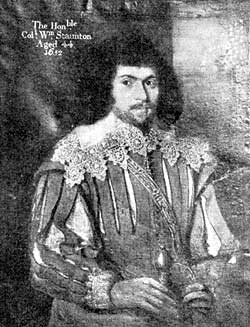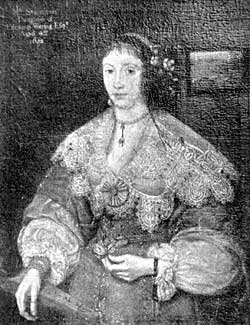County Families and Mansions: STAUNTON HALL
By the Rev. G. W. Staunton
DURING the two centuries following Thomas Staunton—whose rent roll is referred to in the previous article—his descendants lived on their estates which, however, were much diminished during the lifetime of William Staunton who succeeded in 1582, and who married Elizabeth, daughter of Daniel Disney of Norton Disney. This lady proved a most extravagant wife to the good-tempered William. She is said to have stolen a large sum of money which was in the house when her husband died and which was intended for the redemption of Flawborough, mortgaged to Stanhope of Shelford, who was pressing for his debt.
Moreover, among the Staunton documents has been discovered a bond given by this woman eight days after the death of her husband, in which she binds herself by a penalty of 1,000 marks to marry Charles Wilson of Staunton before the 20th of September next ensuing.

Colonel Wm. Staunton 1652.

Anne Waring, wife of Col. Wm. Staunton.
Leaving two generations unchronicled, we come to William Staunton of the Civil War who had succeeded to his father's estates in 1613. Like the two previous owners he fell ward to the Earl of Rutland, but the wardship was redeemed by his uncle, Palmer.
Married to Anne Waring, he had six sons and seven daughters, but the appalling infant mortality of the day carried off six of these children. One of the daughters married William Sacheverel, and from this marriage most of the ancient Derbyshire families such as the Sitwells, Wilmots, and Batemans are descended.
When King Charles raised his Standard at Nottingham, William Staunton attended him, and followed him to Shrewsbury and to the Battle of Edgehill. He was then given a Colonel's commission and proceeded to raise a Regiment of 1,200 Foot, and a troop of Horse, and provided for them at his own expense.
When Newark was surrendered, William Staunton, whose regiment formed part of its garrison, laid down his arms, but for some reason, not explained, he was treated more harshly by the Parliament than the other officers of the garrison as the following petition shows:
Petition of William Staunton
"To the Right Honble. the Comission for Composition with Delinquents sittinge at Goldsmiths' Hall.
The humble petition of William Staunton, of Staunton in the County of Nottingham, Esqr.
Sheweth,
That your petitioner submittinge to the fine imposed on him for his delinquency, did, accordinge to order, pay one moyty unto the treasurie of this Comittee, and although he hath used his utmost endeavours by all means possible for paiment of the remainder, either by mortgage sale or otherwise, yet by reason of his greate sufferinge in his goods, fellinge of his woods at the seidge of Newarke for the use of the state, with which he should have raised money, the many judgments and extents upon his estate not allowed him, and being through mistake much overfined, hee comeing in upon the articles of Newarke, but not allowed him as to others comprised within the said Articles; by reason of all which your petition is utterly disabled to raise money for his second paiment unlesse you shall afford him the like mercy as others have received in his condition.
May it therefore please your honors in kinde consideration of the premises, and out of your accustomed clemency, to recommit the cause of your petitioner to the sub comitee that be they may make report thereof to your honors as they shall finde the case to appeare.
For which he shall ever pray, &c.
[Endorsed] Recd 4 May 1649
and admitted and referred
to the examination and
report of the sub comittee.
Jo: Leech."
Particulars of the damage caused by the Parliament soldiers in Staunton to Colonel Staunton's property, estimated by him as follows:—
| Loss of household goods | £300 |
| Woods cut down | 300 |
| Spoils and waste committed on | |
| his houses | 2000 |
| — £2600 | |
It would be interesting to give the history of this Cavalier at greater length, but lack of space prevents this.
The Staunton documents contain Commissions signed by King Charles for the appointment of the necessary officers in Col. Staunton's Regiment, and many other papers relating to the occupation of Staunton Hall by the Parliament soldiers in 1645, the looting of its contents, and the damage caused to the house.
Among the papers recently brought to light are the accounts of Gervase Hewet, whose commission, signed by William, Earl of Newcastle, appointing him to a lieutenancy in the Regiment of Harquebusiers commanded by Col. Staunton, is still preserved at Staunton.
These accounts show that Colonel Staunton lodged at the "Hart" at Newark during the siege, and contain such items as "10 April 1645. For cleaning ye Street against Wid Taylor's 2s." One wonders why Widow Taylor was so favoured. On 15 April, 1645, he paid £8 to Sir Gervase Clifton, and on the 20th of the same month he paid £1 "To Porter for teaching ye Trumpeter to Sound."
Other interesting entries are such as "To John Clarke and Mr. Wright for ye time of their imprisonment at Nottingham 10s.," and "To ye Souldiers at ye Sconce for bread and cheese 3s." The fortification known as the Queen's Sconce is still to be seen at Newark.
William Staunton returned to a ruined home and estate; and his resources were further diminished by unjust fines and levies by Parliament, and by his having to repay part of a loan raised for the defence of Newark by the King's Commissioners of Array, for which, as further security, the Commissioners had given their personal bonds. From this time on, until the Restoration, the Staunton documents are a dismal record of mortgages and sales which seemed destined to wipe out the property altogether.
Major Staunton succeeded to the remnants of the estate, and still further reduced it by his extravagance; but, dying young, was followed by his brother, Harvey, who married the heiress of George Cam, of Tuxford, with a dowry of £9,000.
Harvey Staunton was the last male heir of the Stauntons after a continued succession of over 600 years: "The last of that beloved family," as a tablet in the church erected to Jane Degge, his youngest daughter, gives it. On his decease his estate was divided among his four daughters, his two sons having died in their youth; but by a family arrangement the shares of the three younger daughters were purchased by Gilbert Charlton, who had married Anne, the eldest.
This Gilbert Charlton was the second son of Sir Job Charlton, of Ludford House, in the County of Hereford, and Lettice, daughter of Walter Waring, of Oldbury, a connection of Colonel Staunton's wife. Sir Job was Speaker of the House of Commons in Charles II reign. Roger North speaks of him as "an old Cavalier, loyal, learned, grave, and wise." It was he, no doubt, who provided the £6,100 required to buy out the younger sisters of his daughter-in-law, and he left his son, Gilbert, an estate at Trehellig, in Montgomeryshire, which, producing about ,£130 per annum, cost Sir Job £2,000 in 1686, and was sold in 1717 for £2,350, the money being re-invested in a property at Carlton Scroop.
Gilbert Charlton had two sons and several daughters, the youngest of whom married Richard Brough, of Thoroton, Notts., and from her the present owner of Staunton is descended.
The eldest son of Gilbert and Anne Staunton was named Job Staunton Charlton, and during his minority the estate was administered by his mother, whose account book is well worth studying.
It begins with an inventory of her husband's personal property, from which we see that the "Best Chamber" contained a crimson velvet bed, with silk linings, quilt, feather bed, and blankets, valued at £25.
The "Boarded Chamber" contained a china stuff bed, etc., valued at £6 15s. 0d., and also in this room there was tapestry valued at £3 10s. 0d.
The kitchen was well furnished containing, among many other things, 4½ stone of brass valued at 8d. per lb., and 13½ stone of pewter valued at 10d. per lb. The inventory of the stable is worth reproducing in part:—
| 5 Cowes at £210s. each | £12 | 10 | 0 | |||
| 2 Coach Mares | 12 | 0 | 0 | |||
| 2 Mares with their Foals, | ||||||
| one blind, ye other lame | 7 | 0 | 0 | |||
| 1 Colt and Fillea | 5 | 0 | 0 | |||
| 2 Gray Horses | 7 | 0 | 0 | |||
| 1 little old Pony | 1 | 5 | 0 | |||
| Sorrell Mare | 5 | 0 | 0 | |||
| Coach, and 4 Harness | 26 | 0 | 0 |
During her administration of the estate Anne Charlton got into serious financial difficulties, and her account book betrays her constant and unavailing efforts to put the best appearance on her affairs.
On 25 May, 1726, she heads the page, "Given to my son by ye name that one story is good until another is told," and she reveals that she had to relinquish £125 per annum of her jointure to help to pay the debts she had incurred. Immediately after her husband's death she set to work to alter Staunton Hall in accordance with the ideas of the age, and to remake the gardens.
"Wainscoteing ye Great Parlor" cost her £17 1s. 3d., and the "Two Balkes in ye Hall" £5 12s. 0d; and Hewett for "Six Capitolls" was paid £3, while Fisher of Grantham received £1 4s. 0d. for "ye Buffet, viz., 16 lights and setting sun." In a summary of her accounts from 1712 to 1722 she states that her total expenditure on "African and Lotterys" during that period came to £370.
The account book ceases at 1728, but by that time she seems to have achieved (for her) a moderate degree of solvency because though she paid about two-thirds of her income away in interest and repayment of principal she finished the year with a credit balance of £48 2s. 5d., though one rather suspects that the item, "from Mr. Doughty of Grantham £200," looks very like a loan, and if so not part of her ordinary-income.
By this time she had left Staunton and taken a house in Newark, which she appears to have furnished without any great regard for economy.
